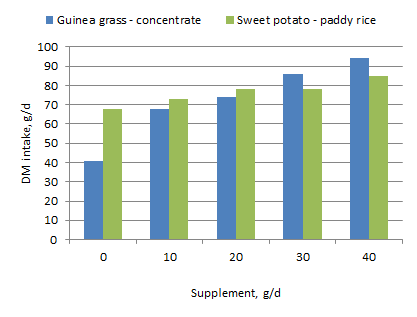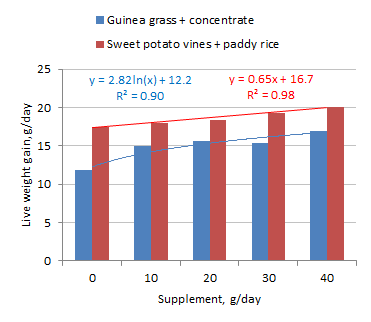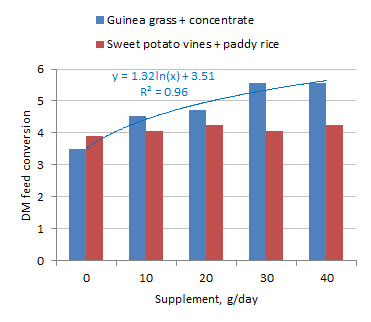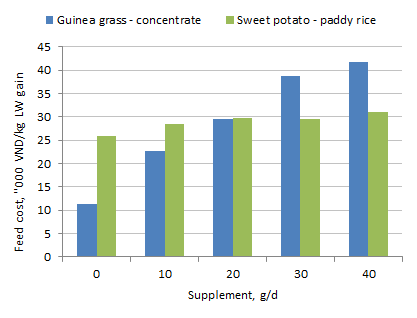 |
| Figure 1. Trends in DM intake of rabbits fed Guinea grass - concentrate or sweet potato vines - paddy rice |
| Back to contents |
An experiment was conducted at the Goat and Rabbit Research Centre to determine effects on feed intake, average daily gain (ADG), feed conversion ratio (FCR) and economic returns of New Zealand White rabbits raised on two feeding systems: sweet potato (Ipomoea batatas) vines with supplementation of paddy rice and Guinea grass plus commercial concentrate. There were 5 levels of supplement (paddy rice or concentrate): 0, 10, 20, 30 and 40 g/head/day. A total of 30 male growing rabbits at 6 weeks of age were equally divided into 2 main groups of 15 each to be fed on either of the two basal diets. Each of the two main groups was further divided into 5 sub-groups (treatments) of 3 rabbits each. The rabbits were housed and fed in individual cages. The experiment lasted 10 weeks following 7 days of adaptation.
The system of sweet potato vines and paddy rice supported higher growth rates and better feed conversion than Guinea grass plus concentrates. In the Guinea grass-concentrates system the feed conversion became worse as the level of supplement increased; in contrast on the sweet potato vine-paddy rice system, feed conversion was the same irrespective of the level of supplementation.
Rabbits are raised almost in all developing countries, and contribute to improving the nutrition and the economy of smallholder families, both as a source of animal protein, as well as a source of extra income through the sale of animals. They can be fed different kind of grasses, tree leaves, fruits (bananas), roots and tubers (eg: cassava and sweet-potatoes), and by-products. In particular they find vegetables such as sweet potato vines and water spinach very palatable. Sweet potato (Impomoea batatas L) can be planted for tuber or forage production, dependent on purpose and season; it can be planted once and cut throughout the year with subsequent harvests every day (Le Van An et al 2003).
Rabbits efficiently utilize fibrous feed by courtesy of their feeding and digestive strategies (Leng 2006). Rabbits can get energy from forages; they always have done in the wild state and their digestive system is developed for this purpose. Among other forages, water spinach (Ipomoea aquatica) and sweet potato (Ipomoea batatas) vines are common vegetables used for rabbit feeding in Vietnam as the basal and even only diet. Both are high in crude protein (>20% in DM), the levels exceeding what are normally recommended for optimum growth rates in rabbits (eg: 16% crude protein in DM; NRC 1977). However, attempt to provider a better balance of nutrients by supplementing the forages with a high energy feed such as broken rice have not been successful (eg: Hongthong Phimmmasan et al 2004). Paddy rice seems to be amore appropriate energy source (Nguyen Huu Tam et al 2009: Inthapanya and Preston 2009). Nevertheless, so far, it has not been clear what is the reason for the response in terms of growth rate to level of paddy rice supplementation. This is a question not only of nutrition but also economics. It is important to know what are the nutritional and economic advantages of a feeding system in which paddy rice is used to supplement protein-rich vegetables.
In the present study the standard feeding system in the Goat
and Rabbit Research Centre, of Guinea grass and commercial concentrates, was
used as the control system.
A total of 30 male growing Newzealand White rabbits at 6 weeks of age were equally divided into 2 main groups of 15 each to be fed on either of the two basal diets. Each of the two main groups were divided into 5 sub-groups (treatments) of 3 rabbits each to receive one of 5 graded levels of paddy rice and/or concentrate, which were 0, 10, 20, 30, 40 g/head/day. The forages were fed ad libitum. The rabbits were housed and fed in individual cages. The experiment lasted 10 weeks following 7 days of adaptation.
Sweet potato vines and guine grass were bought daily from farmers around centre. Paddy rice was bought every 10 days and store in the nilon bag to ensure the huminity. The commercial concentrate was older monthly from the Animals feed Company.
The animals were fed 4 times a day at 8:00h, 10: 00h, 14:00h and 17:00h. Feeds offered and refusals were recorded daily. Fresh water was available for all rabbits almost all day and night time. The animals were vaccinated to prevent of hemorrhagic diseases, treatment internal and external parasite and other common diseases
Live weight was recorded every 10 days, and feed intake daily. Samples of offer and refusal of sweet potato vine and guine grass were taken daily, pooled weekly and analyzed for DM and crude protein (AOAC 1990), and NDF and ADF (Van Soest et al 1991).
Feeds offered and refusals were analyzed for chemical compositions: DM, CP, NDF ADF and Ash following procedures of AOAC 1990, and Van Soest et al 1991, respectively.
The data were analyzed by ANOVA using the General Linear Model (GLM) software of Minitab (Version release 13.31) (Minitab 2000). Sources of variation were: Source of foliage, guinea grass, interaction foliage*guinea grass and error.
The sweet potato vines had more than twice as much protein and less cell wall components compared with the Guinea grass (Table 1). The concentrate had more than twice as much protein as paddy rice.
|
Table 1: Chemical composition of experiment feeds |
|||||
|
|
DM % |
% in DM |
|||
|
|
CP |
NDF |
ADF |
Ash |
|
|
Guinea grass |
18.5 |
9.8 |
55.1 |
32.7 |
14.7 |
|
Sweet potato vines |
12.0 |
22.1 |
42.1 |
29.8 |
10 |
|
Paddy rice |
88.0 |
7.5 |
25.5 |
13.8 |
4.1 |
|
Concentrate |
92.0 |
17.5 |
30.0 |
14.2 |
8.3 |
There were linear increases in DM intake in both feeding systems as the level of supplementation was increased, the slope of the response curve being steeper on the guinea grass-concentrate system (Table 2; Figure 1). This latter effect probably reflected the increase in the protein content of the diet as the concentrate supplement (17.5% crude protein) replaced Guinea grass (9.8% crude protein). On the sweet potato vine diet the contrary relationship was observed as the diet protein content decreased as paddy rice (7.5% crude protein) replaced sweet potato vines (22.1% protein). In both systems the concentrations of NDF and ADF decreased as the supplements were increased. Concentrations of NDF were higher and of ADF lower on the grass system than on the sweet potato vine system; however, it is difficult to draw any conclusions as to the significance of these values in relation to observed growth and feed conversion rates.
|
Table 2: DM intakes by rabbits fed Guinea grass and commercial concentrate or sweet potato vines and paddy rice |
|||||||
|
|
Level of concentrate/paddy rice, g/day |
||||||
|
|
0 |
10 |
20 |
30 |
40 |
||
|
Guinea grass – concentrate system |
|
|
|||||
|
Guinea grass |
41.4 |
54 |
50.5 |
49.1 |
48.1 |
||
|
Concentrate |
- |
13.8 |
23 |
36.8 |
46 |
||
|
DMI, g/d |
41 |
68 |
74 |
86 |
94 |
||
|
Crude protein, % DM |
11.5 |
12.5 |
13.1 |
13.7 |
14.3 |
||
|
NDF, % in DM |
41.7 |
39.3 |
37.8 |
37.8 |
36.1 |
||
|
ADF, % in DM |
23.2 |
21.5 |
20.3 |
20.1 |
18.8 |
||
|
Sweet potato vine - paddy rice system |
|
|
|
||||
|
Sweet potato vine |
68.1 |
59.8 |
56 |
43.4 |
41.4 |
||
|
Paddy rice |
- |
13.2 |
22 |
35.2 |
44 |
||
|
DMI, g/d |
68 |
73 |
78 |
78 |
85 |
||
|
Crude protein, % DM |
23.8 |
21.5 |
19.7 |
17.9 |
16.8 |
||
|
NDF, % in DM |
38.5 |
35.5 |
34.5 |
31.4 |
30.4 |
||
|
ADF, % in DM |
29.0 |
26.0 |
24.6 |
21.9 |
20.8 |
||
 |
| Figure 1. Trends in DM intake of rabbits fed Guinea grass - concentrate or sweet potato vines - paddy rice |
In both feeding systems the growth rate and feed conversion followed the same trend as the DM intake; however, there were consistent differences between the systems with the sweet potato vine - paddy rice diet being superior to the Guinea grass - concentrate diet at all levels of supplementation (Table 3; Figures 2 and 3). The increasingly poor feed conversion as the concentrate level was increased on the Guinea grass basal diet implies that nutrients were better utilized when forage was the basis of the diet. This issue merits further investigation. On the sweet potato vine diet the feed conversion rate was not affected by the level of supplement, in this case paddy rice.
In both feeding systems the concentrations of NDF and ADF decreased as the supplements were increased (Table 2). Concentrations of NDF were higher and of ADF lower on the grass system than on the sweet potato vine system; however, it is difficult to draw any conclusions as to the significance of these values in relation to observed growth and feed conversion rates. Similarly the variations in diet crude protein content (Increasing with supplementation on the grass system and decreasing on the sweet potato system) appear to be unrelated to rabbit performance.
|
Table 3. Mean values for changes in live weight, DM intake, feed conversion and feed cost for Guinea grass-concentrate system and sweet potato vine –paddy rice system |
|||||
|
|
Supplement level, g/d |
||||
|
|
0 |
10 |
20 |
30 |
40 |
|
Guinea grass + concentrate |
|||||
|
Live weight, g |
|||||
|
Initial |
810 |
883 |
828 |
830 |
825 |
|
Final |
1520 |
1782 |
1760 |
1757 |
1839 |
|
Daily gain |
11.8 |
15 |
15.6 |
15.4 |
16.9 |
|
DMI, g/d |
41 |
68 |
74 |
86 |
94 |
|
FCR in DM |
3.51 |
4.52 |
4.71 |
5.58 |
5.57 |
|
Feed cost# |
11.3 |
22.7 |
29.6 |
38.8 |
41.7 |
|
Sweet potato vines + paddy rice |
|||||
|
Live weight, g |
|||||
|
Initial |
811 |
756 |
895 |
796 |
785 |
|
Final |
1861 |
1833 |
2001 |
1943 |
1994 |
|
Daily gain |
17.5 |
18 |
18.4 |
19.3 |
20.1 |
|
FCR in DM |
3.89 |
4.06 |
4.24 |
4.07 |
4.25 |
|
Feed cost# |
25.9 |
28.4 |
29.7 |
29.5 |
31 |
|
# VND (‘000)/kg LW gain |
|||||
 |
 |
| Figure 1. Growth rates of rabbits on two feeding systems: sweet potato vines with paddy rice versus Guinea grass with concentrates | Figure 2. DM feed conversion of rabbits on two feeding systems: sweet potato vines with paddy rice versus Guinea grass with concentrates |
 |
| Figure 3. Feed costs per kg LW gain for rabbits on two feeding systems: sweet potato vines with paddy rice versus Guinea grass with concentrates |
The overall assessment of the results indicates that the combination of sweet potato vines and paddy rice has a higher nutritive value than the combination of Guinea grass and concentrates, supporting higher growth rates and better feed conversion. The assessment of feed costs per unit live weight gain indicate that these increase with similar trends as for DM feed conversion (Figure 3). Lowest cost (and lowest growth rate ) was on Guinea grass alone with costs rising steeply with a linear trend as the concentrate allowance was increased (Figure 3). By contrast, on the sweet potato-paddy rice system, feed costs increased only marginally as the paddy rice level was increased. The optimum feeding system, on the basis of the results reported here, would thus be with sweet potato vines and the level of supplementation with paddy rice of 40 g/day since this gave the highest growth rate with minimal increase in costs compared with lower levels. Faster growth rate reduces the fixed costs component of the production system , thus if variable costs (of the feed) are not increased, then the system will be more profitable. However, these relationships will be a function of the actual costs ascribed to the various feed ingredients which will vary according to whether they are purchased or produced with family labour.
AOAC 1990 Official methods of analysis. Association of Official Analytical Chemists, Arlington, Virginia, 15th edition, 1298 p
Hongthong Phimmmasan, Sitone Kongvongxay, Chhay Ty and Preston T R 2004 Water spinach (Ipomoea aquatica) and Stylo 184 (Stylosanthes guianensis CIAT 184) as basal diets for growing rabbits. Livestock Research for Rural Development. Volume 16, Article # 34. Retrieved from. http://www.lrrd.org/lrrd16/5/hong16034.htm
Khuc Thi Hue and Preston T R 2006 Effect of different sources of supplementary fibre on growth of rabbits fed a basal diet of fresh water spinach (Ipomoea aquatica). Livestock Research for Rural Development. Volume 18, Article #58. Retrieved June 8, 2008, from http://www.lrrd.org/lrrd18/4/hue18058.htm
Le Van An, Lindberg B E F and Lindberg J E 2003 Effect of harvesting interval and defoliation on yield and chemical composition of leaves, stems and tubers of sweet potato (Ipomoea batatas L (Lam.)) plant parts. Field Crops Res. 82, 49-58.
Minitab 2000 Minitab Release 13.31 for windows, Minitab Inc., State College Pennsylvania, USA.
NRC 1977 Nutrient Requirements of Rabbits, Second Revised Edition, http://www.nap.edu/openbook.php?record_id=35&page=1
Nguyen Huu Tam, Vo Thanh Tuan, Vo Lam, Bui Phan Thu Hang and Preston T R 2008 Effects on growth of rabbits of supplementing a basal diet of water spinach (Ipomoea aquatica) with vegetable wastes and paddy rice. Livestock Research for Rural Development. Volume 21, Article # 174. Retrieved , from http://www.lrrd.org/lrrd21/10/hang21174.htm
Inthapanya S and Preston T R 2009 Effect of supplementation with sweet potato root and paddy rice on growth performance of local rabbits fed water spinach (Ipomoea aquatic) and paper mulberry (Broussonetia papyrifera) as basal diets. Livestock Research for Rural Development. Volume 21, Article #176. http://www.lrrd.org/lrrd21/10/sang21176.htm
Tam N H, Tuan V T, Lam V, Hang B P T and Preston T R 2009 Effects on growth of rabbits of supplementing a basal diet of water spinach (Ipomoea aquatica) with vegetable wastes and paddy rice. Livestock Research for Rural Development. Volume 21, Article #174. http://www.lrrd.org/lrrd21/10/hang21174.htm
Van Soest P J, Robertson J B and Lewis B A 1991 Carbohydrate methodology, metabolism and nutritional implications in dairy cattle: methods for diatary fibre, and nonstarch polysaccharides in relation to animal nutrition. Journal of Dairy Science 74: 3585 - 3597. http://download.journals.elsevierhealth.com/pdfs/journals/0022-0302/PIIS0022030291785512.pdf